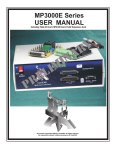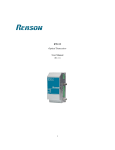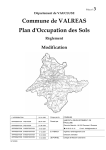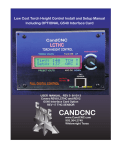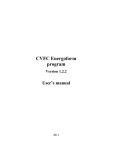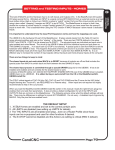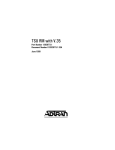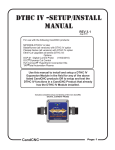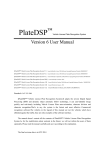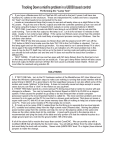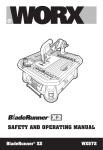Download UBOB - The Ultimate Breakout Board UBOB
Transcript
REV2 12/15/2008 10/15/2008 USER MANUAL REV3 Covers UBOB, UBOB Builders Kit. For ver 4 1 and 6 2 of UBOB Contents: ! Overview/Features ! Quick Start ! Overlay and parts locations ! Graphical schematic of common connections ! Step by step hookup and inital testing ! Final setup and calibration ! INTRODUCTION UBOB - The Ultimate Breakout Board J A breakout board is designed to take low level logic signals from a PC parallel port and buffer (amplify) them and shift them to standard 5 volts from a lower logic type such as the newer 3.3V logic levels found in a lot of new Motherboards and laptop parallel ports. In addition it provides a level of protection from the noise and spikes of the outside world using Opto Isolation. That breaks the grounds apart and prevents noise from being transmitted across a common connection. The UBOB uses two distinct regulated power sources not connected through a common ground to drive the isolated inputs. The internal logic runs on a PC referenced (same ground as the PC) + 5VDC. The “floating voltage” is a 12VDC supply that provides a totally separate ground and voltage source to drive the input optos and external relays on the optional Table I/O II The limiting factor of all breakout cards is that there are only a specific number of discreet inputs and outputs on a standard parallel port. The normal parallel port has the following I/O capability under control of MACH or EMC: 12 high speed outputs for Step & Direction and/or relay interface. Typically 8 are used for 4 axis of motion, one is used for the Charge Pump (more about that later) and three are open for auxillary outputs (relays, enable pins, etc). Even more limited is the inputs. There are only 5 and one is for E-stop. That leaves the other 4 for Homes and limits, probes, index inputs, etc. The UBOB is the first BOB design to utilized an advanced Port Stretcher Technology that expands the I/O FROM A SINGLE PORT to: 9 high speed (step & Dir + Charge Pump)outputs, and 8 low speed aux outputs for relays. All 8 lines are double buffered and can handle several hundred milliamperes of current each. The inputs are expanded from 5 to 9 providing the added inputs to setup probes, or handle other external signals (external rotary encoders CANNOT be used). The UBOB uses Surface Mount Techology to keep the size down and supports a wide array of plug-in option cards. It ships with a free custom plug-in to handle the advanced port expansion capabilities The UBOB is design to be a stand alone BOB and port interface or to interface with our EZPlug© Gecko Interface Cards to quickly build anything from a 3 axis table top router/mill to a 5 axis 5 X10 router/plasma table. The following document covers setup, configuration and testing of the basic UBOB including the setup in MACH3. Several of the common option cards are covered. If you bought a “Builders Pak” or other package deal this manual can serve as a reference for all of the cards. If you bought just the bare bones UBOB you will not have the other option cards in this manual. You can always purchase them at any time and upgrade your UBOB. INTRODUCTION The UBOB is a third generation, powered, isolated Breakout Board. It is a unique and radically different deign from our previous Breakout products. The UBOB requires the version of MACH shipped on the CD (or later versions we can certify) AND our MACH specific plug-in (UBOB.dll). IT WILL NOT WORK WITH OLDER MACH VERSIONS THAN 3.041 and the PLUG-IN MUST be installed and configured for the outputs to work correctly. Please take a few minutes to go down the QUIK START List to make sure you have the basics in place. QUIK START LIST. Do the following setup with a motor(s) disconnected from your table (or drive belt removed) to confirm proper setup and motor rotation/direction ! MACH version from CD (or download) installed/updated. Version 3.042.020 required (See Addendum section for software step-by-step) ! If you have a version of MACH running with another Breakout make a copy of the (entire) MACH folder as a backup. You can open it and retrieve the motor tuning and other custom settings to save time. ! INSTALL from CD or Download Run INSTALL and files show up in MACH ! Use the MP3000-Install. That will setup the UBOB and all the cards. ! Open Config Plugins from MACH3 menu and verify CCC_UBOB plug-in is ENABLED (Green Check) ! For Builders Pak and modular products see the section on hooking up power. The UBOB needs a source of +5 and (separate) source of +12 both at 500ma. The Quad Power Module (Only one side populated for UBOB applications) uses a single ribbon cable interface to power the UBOB and Table I/O cards. ! Power up UBOB and connect to computer (PC) parallel port one (Port1) ! Serial port interface is not required for basic operation. On UBOB ONLY installs there is no serial communications. The UBOB serial is a pass-through for other CandCNC devices/expansion cards. ! Connect the Table I/O card and make sure the EPO jumper on the card is in place. (also sse the MTA card and notes about the EPO jumper there) ! Get the UBOB installed WITHOUT Homes or Limits to begin with. ! The proper Ports and Pins configuration for the UBOB is in the MP3000 profile(XML). When you select that profile in the MACH loader you should only have to make changes in the Motor Tuning and Motor Outputs (Dir change). The only other changes might be in Homing/Limits as to the homing direction. ! Make sure in MACH running the MP3000 Profile you can come out of RESET ! Turn all the power off and connect up the Axis I/O cable to the MTA100 Card. That card is designed to be a multi-purpose breakout for direct (screw terminal) connections to motor drives that use Step & Direction and a Common connection, or by using ribbon cables, connects directly to our EZPLug Stepper or EZPlug Servo interface cards. Sections of this manual cover the interconnects. ! The circuitry in the UBOB requires that the Charge Pump signal from MACH be OFF in RESET The default setup profile has that set right...do not change it. ! Once you have the motor drives connected and DC power to them (supplied by a separate DC motor power supply). the motors should “lock up” when DC power is supplied. Start with just one motor (X). Confirm lockup and then with the UBOB powered up and the DC power to the motor drives jog the X axis from the keyboard using the left and right arrow keys. !Confirm the other axis jogs by moving the X motor Make sure you turn off DC to the drives BEFORE you plug or unplug a motor! !The Inputs for Homes, limits, probes, etc are via the Table IO card and into the Table I/O connector to the UBOB. There are also two relays on the Table I/O card that are controlled by Output1 and Output2 in MACH. By default those outputs are setup to be triggered by Spindle on/off (M03/M05 G-code commands) and by M06 and M08 for the output2. There are also buttons on the Program Run Screen we supply. QUICK START IMPORTANT!! UBOB To PC Serial (Optional) TO PC Port1 Power Supply +5 & +12 Regulated AXIS I/O Table I/O MTA100 Card TABLE I/O Multiple Inputs Switches, probes, sensors BLOCK DIAGRAMS SWITCHED POWER BASIC UBOB BUILDERS PAK HOOKUP 1 PPORT1 1 Q2 Q4 Axis Slave PLUG Q9 AXIS I/O RN2 Q5 U5 C1 UBOB Plug ID U8 CP U3 U2 C5 SERIAL J4 POWER 2 Serial port is optional not used with just UBOB TO PC TO PC REV4 27 UBOB FLOAT-GND +12 PCGND +5 CONNECTOR ID SKT J29 FEATURE CONN PC+5 PCGND 10 Primary Parallel Port (PORT1 /LPT1) Q3 1 1 1 Q1 PORT2 INTERCONNECT 1 1 1 TABLE I/O 1 J2 AXIS I/O 1 J6 J7 J65 UBOB REV 6 Plug ID PLUG AXIS I/O TO PC J56 J1 + Primary Parallel Port (PORT1 /LPT1) 14 1 PPORT1 J63 1 1 TABLE I/O 1 CP U3 C1 1 U2 C5 SERIAL C12 REV6 FEATURE CONN SKT J29 UBOB POWER PORT2 INTERCONNECT 1 J57 1 1 J6 1 1 1 1 J2 J8 J7 TO PC FLOAT-GND +12 PCGND PC+5 CONNECTOR ID Serial port is optional not used with just UBOB C7 C8 R2 R1 5VDC 26 27 C4 C5 C10 C3 25 12VDC D17 G-12V REG4 12V Reg REG3 DANGER AREA on TOP AND BOTTOM OF CARD IN YELLOW AREA HIGH VOLTAGE! FLT 12 All other areas are low voltage C1 R8 D14 - C6 ~ 5V Reg D3 D19 R3 ~ 10 9 C11 J13 + 2 1 Quad power 1 J2 PWR X-CONNECT F1 AC INPUT 105 - 125VAC 60HZ The Quad output Power Module is designed to furnish a source of 5V regulated and a separate (floating) source of 12V regulated. It cross connects to the UBOB via a single 10 pin ribbon cable. A source of 120VAC AC is needed. The hookup if the AC into the Power Module is the responsibility of the user/builder. AC volts over about 65 VAC is dangerous and can case seroius injury or death. NEVER MAKE A CONNECTION WITH THE AC CORD PLUGGED IN. If you cannot safely hook two wires up to wall current DO NOT ATTEMPT THE PROCESS, SEEK PROFESSIONAL HELP. There is an area on the card that is at high voltage. DO NOT PICKUP OR MOVE THE CARD with the AC PLUGGED IN! UBOB CONNECTIONS +5 +12 J8 J5 J7 GND Second Power supply for use with BladeRunner and EZPLUG G250 installs. Not populated on UBOB only units Q2 1 PPORT1 C8 SIP3 26 1 AXIS I/O J6 Q1 Q4 AXIS I/O Q3 Q5 RN2 U7 Q9 J65 R2 J56 U5 U6 FAN R9 U15 RN1 SIP1 J63 D17 REV1 C5 PCGND J60 Q6 SERIAL Q7 Q8 UBOB PC+5 U10 R63 +12 SKT J29 D8 25 J4 27 F1 D19 C6 D3 ~ + J13 - ~ 24 Quad power R8 C1 FLT 12 D14 U8 CP U3 U2 U11 D4 C3 PORT2 INTERCONNECT R54 D18 D14 Axis Slave R37 TABLE I/O FEATURE CONN D7 C2 10 9 5V Reg 1 D6 C11 R3 J5 10 9 2 1 2 1 SIP2 PWR X-CONNECT 24 C10 C5 12V Reg J2 POWER C4 C3 10 PIN IDC cable for power interconnect 26 27 25 G-12V D17 12VDC J57 1 J3 C8 C7 R1 R2 +5 +12 GND 5VDC R6 Second Power supply for use with BladeRunner and EZPLUG G250 installs. Not populated on UBOB only units REG3 PWR X-CONNECT REG4 UBOB CONNECTIONS J8 J5 J7 Powering UBOB from Quad Power Module 1 Second Power supply for use with BladeRunner and EZPLUG G250 installs. Not populated on UBOB only units C7 C8 R2 R1 5VDC 26 27 C3 25 12VDC D17 G-12V REG4 C4 C5 C10 12V Reg FLT 12 REG3 C1 R8 D14 F1 FLOAT-GND D19 C6 PWR X-CONNECT + ~ D3 - ~ 24 J13 1 1 1 SKT J29 +12 5V Reg PC+5 R3 PCGND 10 9 Quad power 1 2 1 C11 1 J2 J7 CP C1 1 J57 1 U2 U3 C5 C12 SERIAL FEATURE CONN POWER REV6 PORT2 INTERCONNECT 1 1 UBOB 1 J2 10 PIN IDC cable for power interconnect PWR X-CONNECT J1 J8 J63 14 1 PPORT1 J65 AXIS I/O PLUG J56 + 1 1 TABLE I/O Power Cross Connect to REV 6 card UBOB CONNECTIONS J8 +5 +12 GND J7 J5 Powering UBOB from Quad Power Module J6 J2 1 1 1 UBOB 1 U2 PC+5 PCGND 1 PORT2 INTERCONNECT J7 1 J57 TABLE I/O +12 FLOAT-GND REV6 C5 1 J65 J63 POWER FEATURE CONN J8 U3 + PPORT1 C1 SERIAL J1 1 1 14 PLUG CP SKT J29 UBOB CONNECTIONS C12 1 J56 1 J6 1 AXIS I/O POWERING THE UBOB FROM OTHER SOURCES THAN THE QUAD POWER MODULE If you do not have the Dual or Quad Power Module you can power the UBOB from several sources. The +5 is referenced (shares the same ground return) with the PC +5. The parallel port on a PC DOES NOT HAVE a source of +5 other than leak pull-ups on logic lines. The USB part has a +5 line and the internal power supply of most PC’s has a +5 output. You can get tap plugs that allow access to the internal +5 on a PC. The wires used to power hard drives and CD drives has +5 (Red Blk pair). Make sure the voltage is +5 regulated and NOT +12. You can supply the +5 from any regulated +5 power that can handle a minimum of 250ma. Examples are wallplug transformers, Desktop power supplies (for some laptops, etc) and open board power supplies from hobby sources. The ..1 solderless (crimp on) terminals are marked with PC+5 and PCGND for the 5 volt input. The +12 input HAS to be a separate power supply rated at 500ma or higher with a separate ground return (not connected to the +5 ground return) Most dual output power supplies share the same ground connection so will not work for the required voltages. The +12 drives the inputs of the Opto’s (from the Table I/O card) and also drives the relays. IF YOU DO NOT USE SEPARATE POWER SOURCES WITH THE 12V RETURN COMMON WITH THE +5 (PC GROUND) YOU LOOSE ALL THE ADVANTAGES OF THE INPUT ISOLATION AND THE OPTO’s Do not use the +12 in the PC as it is connected to PCGND. If you do not have or use a 5th motor and driver then the Hardware Slaving option does not matter Hardware Slave shown in “X” Position 2 STEP 4 6 2 1 3 5 1 DIR 4 6 J63 3 5 Axis Slave Both OPTION BLOCKS MUST be jumpered the same. 1-2 External drive FROM PORT2 card 3-4 Slave 5th Axis to X 5-6 Slave 5th Axis to Y AXIS I/O 1 UBOB CONNECTIONS Hardware Slaving Options. If you do not have or use a 5th motor and driver then the Hardware Slaving option does not matter Both OPTION BLOCKS MUST be jumpered the same. 1-2 External drive FROM PORT2 card 3-4 Slave 5th Axis to X 5-6 Slave 5th Axis to Y 1 2 1 J63 2 4 3 5 6 5 6 DIR Axis Slave STEP Hardware Slave shown in “X” Position AXIS I/O 1 UBOB CONNECTIONS Hardware Slaving Options. (REV6) 1 Q2 1 Q3 Q4 Axis Slave PLUG Q9 AXIS I/O RN2 Q5 U5 C1 U8 CP U3 U2 C5 SERIAL J4 POWER SKT J29 FEATURE CONN PC+5 1 PPORT1 Q1 PORT2 INTERCONNECT PCGND +12 PCGND +5 REV4 27 UBOB FLOAT-GND J2 1 AXIS I/O 1 J8 J65 14 1 PPORT1 J63 PLUG AXIS I/O TABLE I/O J56 J1 + 1 J57 CP U3 C1 1 U2 C5 SERIAL C12 REV6 FEATURE CONN SKT J29 UBOB POWER PORT2 INTERCONNECT 1 1 TABLE I/O J2 1 1 1 J6 Remove J6 Jumper if you connect to a G250-5 Card or use the UBOB with any of the Enhanced System Power conrollers (CandCNC product) 1 1 1 1 J7 1 J6 J7 1 1 1 1 J6 E-stop pass through JUMPER REV 6 Card 2 10 J6 Must be jumped if the UBOB is used without a G250-5 Ezplug Drive Module (BladeRunner) or an ESP series Power Controller REV 4 CARD PC+5 FLOAT-GND +12 PCGND DANGER! T13 D3 J5 DANGER! T15 K3 T16 T17 Com1 R2 K4 50 LIMITS NO Com2 C1 C9 K4 DWN J7 J6 J33 C&CNC 47 TABLE I/O REV 6 J9 J10 T20 T21 C14 T5 J8 52 UP 6 J2 1 PLUG 14 AUX3 J12 AUX4 UP BHOME D9 C6 C11 AUX2 J13 J1 T4 AUX0 AUX0 AUX1 EPO C13C12 See hook up details for driving external loads. C10 T7 Normally open contacts. J4 K4 T3 DOWN T8 K4 D2 T2 LIMITS T6 C8 C7 Secondary Relay 10A 48 T19 T18 AHome K3 AHome C5 T9 See hook up details for driving external loads K3 C4 ZHome ZHome K3 Main Relay Output 20A Normally open contacts J11 T14 D15 T11 T10 YHome ARC OK C2 K5 J18 NO R1 ARC OK 49 Xhome C3 The EPO is the E-stop (software) input. IT HAS TO BE CLOSED. A JUMPER IS NEEDED IF IT”S NOT USED WITH A NC Estop Button (not YHome The DOWN, AUX0, UP and ARC OK inputs are also Port 1 inputs and can be used for any switch type input. Xhome HOME INPUTS Use Normally Open Switches. X - A Home are port 1 inputs Limits are typically setup as normally closed and connected in series at the switches with beginning and end of string into the LIMITS Tabs. T12 The TableI/O card provides a breakout of inputs and outputs. It connects to the UBOB via a 25 pin computer cable into the TABLE I/O plug (see overlay next page). The card can be close to or up to 15ft from the UBOB card. You have the option to mount the card close to the UBOB and pull the Homes and other inputs into the card or you can mount the card out on the Table and connect allof the inputs with short runs. Having the Power relays out on the table for larger machines can be an advantage. QUAD RELAY 10 1 13 25 AUX 1 - AUX4 and B Home are PORT2 inputs and only work if you have the optional Port 2 card installed and a 2nd parallel port on thePC active and LED’s are indicators that the circuit is working when a switch is closed. They only come on if the Table I/O is connected to the UBOB and the UBOB is powered up. You can short across an input Pair (example: T12 to T13 for X Home. The LED should light and the X Home Screen LED in MACH for X Home should light. The LED is in series with the Input Opto and is a good indication UBOB CONNECTIONS TABLE I/O II CARD UBOB CONNECTIONS Home and limit switch hook ups Typical connections for Homes and Limits All of the inputs are opto isolated and map to a specific pin on the parallel port(s). In reality you can use any input for any signal. Inputs are not fast enough for Encoder feedback faster than a few pulses per second. The inputs use a “floating” ground (+12 return). If you need more inputs than the 8 (9 with EPO) then a PORT 2 card can be hooked to the UBOB and the added Aux and BHome inputs will work with a second parallel port. Normally closed contacts For far limits. Wired in series NC C C NC C YHome C NO XHome ZHome T17 K5 T3 UP T4 EPO T11 ARC OK J1 C14 49 D15 BHOME AUX1 D3 J13 R1 K3 AUX2 J12 K4 DANGER! R2 J18 AUX3 J8 AUX4 QUAD RELAY HEADER is for an optional quad relay card and adds 4 more relays to the outputs. J5 C11 NO Com2 Com1 48 NO J4 C10 Xhome K3 K4 DANGER! J7 J11 YHome D2 10 13 25 C&CNC 47 TABLE I/O REV 6 J6 T13 K4 C13C12 QUAD RELAY J10 J33 C1 6 1 J9 K3 D9 T21 T15 ZHome AHome LIMITS DWN AUX0 UP 14 1 T20 T12 C2 T10 AUX0 DOWN T2 T19 50 T14 ARC OK LIMITS AHome C9 T16 C4 C3 T18 ZHome T6 NO C NO YHome T5 52 T7 C5 T8 C8 PLUG C7 C6 J2 T9 C Xhome JUMPER EPO to be able to bring MACH out of RESET NC UBOB CONNECTIONS ^6 RELAY SETUP USING OPTIONAL QUAD RELAY EXPANSION CARD or QUAD RELAY BOX See Quad Realy Manual for Connection details L2 HOT BREAKER B BREAKER A & B J14 B PLUG HOT J3 J7 D9 PLUGS NEU K3 K5 J10 + SFTY GND K4 J9 K2 L1 NEU J8 A PLUG HOT Outputs for 2 low Current Relays QUAD RELAY EXPANSION CARD 34 33 + BREAKER A Not Used J17 1 SKT J2 Db9 Fem to DB9 Male EXTENSION CABLE up to 25ft can be used IDC 10 to DB9 Male Adapter AUX0 DOWN T2 T3 UP T4 EPO J1 C14 T11 ARC OK D15 AUX1 D3 R1 AUX2 K3 J12 K4 R2 J5 AUX3 C11 J18 Com1 48 NO Com2 NO J4 BHOME J13 C10 K5 K3 K4 DANGER! DANGER! J7 J11 Xhome D2 J8 AUX4 REV 6 C1 10 13 25 C&CNC 47 TABLE I/O J6 49 K4 C13C12 QUAD RELAY J10 J33 K3 D9 6 1 J9 T13 YHome ZHome AHome LIMITS DWN AUX0 UP 14 1 T20 T21 T15 T10 T17 T12 C2 ARC OK LIMITS AHome T19 50 T14 ZHome C9 T16 C4 C3 T18 YHome T6 Xhome T5 52 T7 C5 T8 C8 PLUG C7 C6 J2 T9 J5 K3 C3 ZHome T17 Com1 R2 48 50 LIMITS NO Com2 C1 C9 K4 DWN T21 J7 J33 C&CNC 47 TABLE I/O REV 6 J9 J10 C14 T5 C10 J8 52 UP 6 J2 AUX3 J12 AUX4 UP BHOME D9 C6 C11 AUX2 J13 J1 T4 AUX0 AUX0 J6 C13C12 AUX1 EPO T20 T3 DOWN T7 J4 K4 C7 T8 K4 D2 T2 LIMITS T6 C8 J11 T19 T18 AHome K3 AHome C5 T9 Card will plug directly into DB25 adapter or can be used with a 15 ft or shorter DB25 extension cable. K3 C4 ZHome T16 Connection of TABLE IO Card to UBOB. QUAD RELAY 10 1 1 13 25 PLUG 14 DB25M to DB25F Extension Cable of appropriate length IDC to DB25 Female cable adapter (Furnished) J3 1 J57 PORT2 TABLE I/O J63 Axis Slave INTERCONNECT J65 AXIS I/O 1 C1 FAN PPORT1 SERIAL CP IND PLUG PORT1 DB25 UBOB CONNECTIONS D3 DANGER! T15 DANGER! 49 T13 T12 C2 T14 D15 T11 T10 YHome YHome J18 NO R1 ARC OK K5 ARC OK Xhome Xhome J24 J25 J23 J22 J21 J20 Z-A B - Y' 2 1 2 1 Encoder V J1 2 1 Drive Common C2 J52 1 1 R2 220 U6 9 S&D CARD J19 2 1 Q1 10 9 J52 MINI-IO IN 2 2 1 PC +5 1 D3 20 19 J18 J55 J5 J6 PC GND AUX PWR IN J4 C7 D6 C6 D5 C11 D4 C10 C3 10 S&D Test C9 U5 C4 .15 63V D2 J26 2 1 2 1 DB25 1 TABLE I/O J3 26 DB25 PSC Interface IDC - 20 1 D1 AXIS I/O IN J2 J34 J55 J16 5V Source 1 +5 C8 1 MTA100 REV2 CandCNC X-Y MTA100 Card not used in BladeRunner IDC to IDC short interconnect cable for close mounting DB25 Male to DB25 Male Extension cable Up to 5 meters J3 J63 J3 1 1 J57 PORT2 TABLE I/O 1 Axis Slave INTERCONNECT J65 AXIS I/O TABLE I/O C1 FAN PPORT1 SERIAL CP IND PLUG PORT1 DB25 UBOB CONNECTIONS Interconnect of MTA100 Card and UBOB REV2 INTERFACE CARD JUMPER SETTINGS FOR MTA100 REV2 CARD. DEFAULT SETTINGS ARE SHOWN Most installs will use these settings For Interface to UBOB set J26 (upper left) to pins 2-3. pin 2 is the center pin, and pin 3 J55 J26 R2 220 2 1 J55 J6 PC GND AUX PWR IN 2 1 1 J22 Q1 1 U6 A PC +5 J23 2 1 J5 D3 D6 D4 D5 D2 D1 DB25 J34 2 1 Dir STEP Dir STEP Dir STEP Dir Screw Terminals for Hard wiring Drives (non-EZPLUG) STEP +5 For +5 Common Drives +5 +5 For +5 Common Drives +5 GND For GND Common Drives (Gecko 203) GND MTA100 REV2 J2 Encoder V J1 1 C2 C7 C6 C11 C3 C10 C4 .15 63V Drive Common J4 B - Y' 5V Source 1 +5 C8 C9 J24 26 1 10 J18 J52 MINI-IO IN 10 9 S&D CARD J19 9 Z J25 DB25 J52 S&D Test J20 2 1 J16 Z-A 2 J21 CandCNC U5 AXIS I/O IN 1 20 19 2 1 Y X-Y 1 2 X J4: Sets the source of 5V for Servo Card Encoder. CAUTION DO NOT CHANGE THIS UNLESS YOU ARE TOLD to DO SO. This option is for systems running encoders that draw more than 50ma. Ours do not. UBOB CONNECTIONS MTA100 Card not used in BladeRunner PSC Interface IDC - 20 4N35 4N35 J4 C3 ISO6 CP C4 C3 J14 CON10 X-Connect J14 +5 FLT FLT GND J5 2 1 ISO5 ISO7 J10 + J6 PCGND Not Used J7 +5VDC Light Gray inputs NOT USED ISO2 Port2 INPUT ISO1 4N35 ISO7 4N35 ISO1 4N35 ISO6 ISO4 ISO2 ISO4 4N35 ISO5 ISO3 ISO3 4N35 C&CNC Port2 REV4 To PC PORT 2 via M-M DB25 Extension C4 2 1 U20 J8 CP LED PWR 1 J2 NCP U21 10 9 IDC to DB25 Female Adapter U20 J3 IDC to DB9 Male FOR MPG101B Hookup MPG-101 1 2 1 PORT2 I/O MPG 26 to 26 IDC Ribbon Cable 1 J3 1 +12 K7 J57 TABLE I/O K8 PORT2 INTERCONNECT Axis Slave J60 FLOAT-GND J59 UBOB J65 PCGND REV1 PC+5 FLOAT +12 J61 1500MFD 16VDC J58 POWER J63 J62 AXIS I/O PWR 1 C1 FAN PPORT1 SERIAL CP IND PLUG PORT1 DB25 FEATURE CONN 1 UBOB OPTIONS ADDING AN OPTIONAL PORT2 CARD FOR I/O EXPANSION Table I/O Card Optional Step & Dir Monitor Card D6 16 15 20 19 J4 +5 D5 D4 D2 D1 1 FP Card DC Motor Volts 48 to 65 VDC J9 5V Source 2 1 2 1 C1 J19 UBOB S&D CARD D3 J17 DB25 <16ft NOT TO SCALE J18 J55 Gecko Stepper Interface Card CandCNC OR Gecko Servo Interface Card CandCNC GECKO GECKO GECKO GECKO Z MOTOR A MOTOR Y MOTOR X MOTOR B - Y' Encoder V J1 Drive Common J3 1 1 GND DC Volts to Interface Cards BLOCK DIAGRAMS CandCNC Carries a complete line of card level and box level Solutions for CNC builders. All our products are design to work together All connections to motors have plug connectors Furnished with Cards 10 pin ribbon cables 10” Quick and Easy 3 or 4 axis Controller 10 9 2 1 10 9 2 1 10 9 X Y Z A J20 J21 J22 J23 J24 2 1 10 9 2 1 AXIS I/O IN PSC Interface Parallel Port MTA100 Mass Termination Adapter 1 J2 PC +5 MINI-IO IN J50 J19 J34 J5 PC GND RS J6 J8 J7 Remote Shutdown J52 U5 J55 1 EXT Port CandCNC MULTI-AXIS INTERFACE REV1 1 PC withMACH3 Z-A J25 X-Y UBOB (not to scale) DB25 <16ft D6 16 15 20 19 Encoder V J1 Drive Common J3 1 1 +5 GND D5 J19 D4 D2 D1 FP Card X Y J55 S COM D Y MOTOR BLOCK DIAGRAMS GECKO A MOTOR D S C GECKO Z MOTOR GECKO GECKO X MOTOR MOTOR POWER AND ENCODER (Servo models) CONNECTIONS NOT SHOWN GND Common for Gecko 203 Common B - Y' See Page 5 for screw terminal signal names J9 J4 2 1 2 1 C1 10 9 2 1 10 9 2 1 10 9 2 1 10 9 S&D CARD D3 J17 PSC Interface AXIS I/O IN 2 1 J20 J21 J22 J23 Z A J18 LOW Cost Interface with discreet wiring MTA100 Mass Termination Adapter 5V Source J2 PC +5 MINI-IO IN 1 J34 J5 PC GND RS J6 J8 J7 Remote Shutdown J52 J50 J19 J24 J55 1 EXT Port CandCNC MULTI-AXIS INTERFACE REV1 1 U5 1 J25 Z-A DC Volts to Geckos X-Y UBOB CONNECTION TO G250-5 EZPlug Motor Driver Interface J26 SHIELD GND J27 J63 REMOTE POWER GND +12 J52 J18 J21 1 DC+ 50VDC MAX G S D C9 Q3 G7 1 J2 EPO K2 J55 EPO J9 G-POD A C2 J17 G6 G-POD Z C15 G-POD A G-POD Y C14 B C5 105 G8 104 G9 101 102 G-POD X A Z G10 Y 103 J1 X J5 J4 R12 HOT! J33 1 1 REV0 1 F3 CANDCNC EZPlug 250-5 J47 J24 16 15 J56 1 G2 AXIS I/O DC NEG 2 26 1 25 UBIB Uses AXIS IO Connection for interface to G250-5 1 J57 TABLE I/O J63 Axis Slave +12 K7 PORT2 INTERCONNECT J60 FLOAT-GND J59 UBOB J65 PCGND K8 REV1 PC+5 POWER J3 1 FLOAT +12 1500MFD 16VDC J61 J58 J62 AXIS I/O PWR 1 C1 FAN PPORT1 SERIAL PLUG TO PC TO PC Primary Parallel Port (PORT1 /LPT1) J29 Serial port is optional not used with just UBOB PORT1 DB25 DB9 FP CP IND Not Used FEATURE CONN 1 BLOCK DIAGRAMS 1 D4 G3 G4 S&D Monitor G5 2 1 FRONT PANEL ADDENDUM SECTION Following Pages includes information that aids in setup and testing 4Hooking up AC loads to the Table I/O card 4Pinout Chart 4SOFTWARE INSTALL. 4MACH3 Load 4BladeRunner Install (includes UBOB Drivers) USING OUTPUT RELAYS TABLE IO CARD II Connect Safety ground (GreenWire) on equipment that has three conductors DANGER: High Voltage present. Do not connect with power applied Hot (L1) Use wire size rated for the continuous current of the load #16 up 5A (10A peak) #14 up 10A (15A peak) #12 up 15A (15A peak) Main Output Normally Output 1 for spindle motors 20A @240VAC Max SPST Relay K3 NO NC C SPDT 10A Max NO High Current Load (up to 20A) Note: Current ratings for wires are approximation ONLY. Factors such as ambient temps, insulation type, length of run, bundled or unbundled, etc. make exact ratings difficult. Use this as a general guide only and follow the recommendations of your equipment manufacturer. Use at least the wire size of the equipment cord. Use commercial splices and heatshrink on all terminals or a sealed electrical box. Load can be any AC inductive (motors) or resistive (lights) load up to 20A. Outputs K4 and K5 are rated to 10A max. #10 up 25A (35A peak) #8 up 35A (45A peak) PORT1 I/O Pins PPORT PIN PPORT # OUTPUT TO FUNCTION POLARITY TYPE 1 1 Shift Active High Control MUX 1 2 STEP X Active High Out AXIS IO Pin 2 1 3 DIR X Active High Out AXIS IO Pin 3 1 4 STEP Y Active High Out AXIS IO Pin 4 1 5 DIR Y Active High Out AXIS IO Pin 5 1 6 STEP Z Active High Out AXIS IO Pin 6 1 7 DIR Z Active High Out AXIS IO Pin 7 1 8 STEP A Active High Out AXIS IO Pin 8 1 9 DIR A Active High Out AXIS IO 9 1 10 ESTOP Active Low Input AXIS IO Conn 1 11 X Home Active Low Input TABLE-IO PIN 14 1 12 Y Home Active Low Input TABLE-IO PIN 15 1 13 Z Home Active Low Input TABLE-IO PIN 16 1 14 Output 18 Active High Control MUX 1 15 A Home Active Low Input TABLE-IO PIN 17 1 16 Output 19 Active High Control MUX 1 17 Charge Pump Active Low Safety N/A 1 18-25 PCGND Axis IO Pin 10 Virtual Pins are used to provide mapping to shared inputs and muxed outputs. They are setup in MACH using Non-Hardware Port numbers. Virtual Outputs (MACH) 4 1 Output 5 Active High K1 TABLE IO PIN 13 4 2 Output 3 Active High K2 TABLE IO PIN 12 4 3 Output 1 Active High K3 TABLE IO PIN 11 4 4 Output 2 Active High K4 TABLE IO PIN 10 4 5 Output 8 Active High THC ON /SS ON 4 6 Output 7 Active High SS REV 4 7 Output 6 Active High K6 TABLE IO PIN 25 4 8 Output 4 Active High K5 TABLE IO PIN 9 8 8 8 8 11 12 13 15 Limits Arc OK THC Up THC Dwn Floating GND Floating +12 EPO AUX1 AUX2 AUX 3 AUX 4 Virtual Port Pins (MACH) Active Low Input Active Low Input Active Low Input Active Low Input Input Input Input Input Input TABLE IO PIN 1 TABLE IO PIN 2 TABLE IO PIN 21 TABLE IO PIN 24 TABLE IO PIN 5&6 TABLE IO PIN 18&19 TABLE IO PIN 20 TABLE IO PIN 3 TABLE IO PIN 4 TABLE IO PIN 7 TABLE IO PIN 8 Software Install Instructions If you are installing from the Support CD you can find the MACH3 ver 3.041 in the BladeRunner\MACH-PROG folder as Mach3VersionR3.041.exe. If you are installing from a web download you will first have to UNZIP the files you downloaded and place them in a Folder on your PC. Name the folder something that you can easily identify later. Unzip the files all into that folder (MACH3 program, BladeRunner-Install.exe, etc) While MACH will run under Windows Vista a lot of other programs you may need won’t. Vista uses LOT’s of resources so your PC needs to be the fastest one with 2G of RAM to have a shot at making it work. We do not currently support Vista so PLEASE don’t call and ask for support for MACH from us if you are running anything but WIN2000 or XP (any level). A NOTE ABOUT HARDWARE (PC) THAT YOU NEED TO RUN MACH: 1. Not all hardware is compatible with MACH3 regardless of how fast the PC is. It’s rare that a PC rated over 1.8GHZ won’t run MACH but not unheard of. Usually the problems show up as jerky motor movements, bad motion in running code and other control problems. Things like Inputs and Outputs and not getting any motor movement is NOT typically a MACH / PC issue. If in doubt about the ability of the PC run DriverTest.exe (With MACH not running) located in the MACH3 folder. 2. The minimum computer recommended is a 1 GHZ processor with 256MRam. We find that a 1.8 or 2.4 GHZ with 512M RAM tends to work better especially if the MB has on-board video. The higher you can run the core freq in MACH the more Steps per Second you can get and the smoother the pulse train of those steps. There are also Windows processes that can effect the timing in MACH. Never run realtime virus protection or other “tray” programs not need for basic Windows functions. Start Install of MACH3 software by clicking on the MACH3ver3.041.exe file . If you already have a version of MACH on the PC, you will be prompted to upgrade the version. Let it upgrade. If you have a version NEWER than 3.041 then you will need to first uninstall that newer version. Make a backup of the XML and SET files in the new version first THEN remove and re-install. You will see the screen above when you start the install. After You Install MACH you will see that it has placed 3 or 4 ICONs on your Desktop in Windows. To check the install click the Mach3Mill Icon and make sure MACH loads and you get a screen. That setup/screen WILL NOT RUN the BladeRunner and does not have the correct Plug-ins for the UBOB (used in the BladeRunner). YOU SHOULD NOT EVEN HAVE YOUR HARDWARE CONNECTED TO THE PARALLEL PORT AT THIS POINT! The Next step in the install is to find the INSTALL.EXE either in BladeRunner Folder on the CD OR in the UNZIPPED BladeRunner-Install.zip file. The BladeRunner Auto Install does the following: ! Installs the custom XML (Profile) and SET (Screen file) files into the MACH3 directory ! Installs the 3 custom Plug-ins used in all of CandCNC’s products including the Pendant plug-in. If you are not using the serial communications or pendant you can disable the plug-ins in MACH later. It won’t hurt to leave them running. ! Adds in the proper side files for the screen files (embedded VB) ! Removes the default Icons MACH installs on the Desktop (except for LOADER) and puts a BladeRunner Icon on the Desktop so you can start your BladeRunner directly from that ICON. ! Removes unneeded XML’s from MACH so they don’t show up in the Loader List. ! Replaces the MACH engine with a special engine configured for the UBOB Below are a few of the dialog windows you see when running the CandCNC BladeRunner Install: AFTER you go through the file transfer screens you should be presented with the following dialog box. If you do not see this box and have the option to click OK then the Pulsing Enfine in MACH is not being updated!. If MACH is running (even minimized on the Desktop) it will not let you replace the Engine and MACH will not run the BladeRunner correctly. Contact us and we can tell you how to do the steps manually to replace the Pulsing Engine After you finish the BladeRunner Install Process: !Reboot the PC and select the BladeRunner Profile by using the Desktop Icon OR from the BladeRunner Entry in the Mach Loader list. !Go to the Quik Start Section and hook up your hardware. NOTE: The BladeRunner Monitor section of the screen (Lower right) will not display parameters if you do not have the Serial Port on your PC connected to the BladeRunner Serial Input on the front panel. See the BladeRunner User Manual for more informatrion. DRILL TEMPLATES 1:1 draiwngs for drill holes Mounting Hole Drill Template UBOB All REV # PPORT1 1 1 PLUG CP 2830 4500 J2 J2 R3 2 1 J3 J3 FAN 10 9 1 J2 DUAL/QUAD POWER MODULE DRILL TEMPLATES 1:1 draiwngs for drill holes 13 C&CNC TABLE I/O REV 6 14 1 D9 1 K3 2.40" K4 10 25 4.31" J2 PLUG 3.11" J24 J23 Y Z J21 J22 1 S&D CARD J20 X J18 3.15" A J25 CandCNC MULTI-AXIS INTERFACE REV1 1 J52 1 J50 PSC Interface MINI-IO IN AXIS I/O IN 14 2 FP Card DRILL TEMPLATES 1:1 draiwngs for drill holes 2 1 10 9 1 MPG MPG-101 2 1 PORT2 EXPANSION CARD Mounting Hole Drill Pattern CON26 Port2 INPUT 1 Step & Dir Monitor (S&D-04A) FRONT SIDE VIEW Drill .125 to .130 dia holes for LED’ s X CNCdnaC riD petS Z Y 2 01 9 1J 01NOC 1 A
































